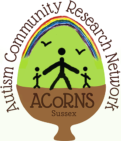The reading for this meeting was an interesting article ‘A new way to diagnose and treat autism’ by Dr Ami Klin who uses eye-tracking technology to quantify sociability by looking at how autistic children view the world. He found that in early childhood, before a diagnosis would be made, children who are later diagnosed have already missed hundreds of social learning opportunities every day. Dr Klin uses a parent-mediated approach where parents are coached to take advantage of these everyday experiences of socialisation in infancy and early childhood. This happens through a bud in parents ears where they listen to a professional to guide them during these interactions.
We discussed how we liked that it doesn’t put pressure on children to be ‘doing it right’ but focuses on how adults can help support them by changing their environment. We also liked that children who may be at high risk of autism can have this support in place in the family home before the child might be clinically diagnosed (which can take months to years). There shouldn’t only be treatment when these autistic children’s experiences become insupportable but instead we should be supporting them from the start to help them to achieve their best possible outcome.
Video interaction guiding (VIG)

VIG is an intervention that uses this same idea of working with parents (or anyone) to improve relationships. VIG allows individuals to watch and reflect on filmed interactions, to look at what’s working well and how it could work even better.
The clear difference with this method is the emphasis on the reflection the parents achieve through VIG rather than being told through a bud by a professional how to act in the situation. This reflection may be key in helping parents feel confident to adjust their behaviours to support their child. Some concerns we had about this bud in the ear used remotely was the person on the other end. Can the professional see the same as being there, how do they compensate for that and how are they tailoring to each individual’s needs? The Chatlab’s Zoom or Room project is addressing the question about communication differences online vs. in person.
More information about the Zoom or Room project can be found here.
Eye fixations and eye contact
 The theory behind this eye-tracking is that the fixations these children make a difference to learning. When two peers interacting in a playground, not looking at the other’s face can miss an opportunity to learn how to socialise. Dr. Klin noted that there are about 500 of these missed learning opportunities every 6 minutes.
The theory behind this eye-tracking is that the fixations these children make a difference to learning. When two peers interacting in a playground, not looking at the other’s face can miss an opportunity to learn how to socialise. Dr. Klin noted that there are about 500 of these missed learning opportunities every 6 minutes.
We debated this by mentioning that although children may not be looking exactly at a certain point e.g. two peers interacting and the autistic child is looking at a swing in the background, this doesn’t mean they are not aware of it. Our peripheral vision is different vision and different attention but it is still important In learning. There are different kinds and uses of vision that changes who we are. However, it is widely understood that as humans we often do fixate on things we are most interested in. So perhaps these children are receiving diminished social interaction by fixating on the ‘incorrect’ places in their environment.
Another discussion followed on from this about eye contact. There is often a stereotype about people with autism that they cannot make eye contact. We spoke about the idea that some people may encourage autistic children them to look straight in the eye. Although this practice is not ‘taught’ to autistic children now, there are ‘comfortable modifications’ taught to them such as looking at peoples ears, noses or where they feel most comfortable. This is crucially important to be tailored to each individual child and what suits them best.
Some parents want that connection with their child through making eye contact. This is why interventions such as VIG are important at helping parents to see how their child makes contact with them, maybe in different ways they had not noticed. In one example given we spoke about how adults actually stopped expecting eye contact and we could see in videos that the child had been attempting to look up to them and were ready to receive eye contact but adults had stopped expecting it. This shows us that VIG and Dr.Klins eye fixations method gives us insight into children’s lives that we might not of noticed in the moment.
What is ‘normal’ sociability?
Following from this idea that children with autism communicate in different ways to ‘atypical’ we discussed what is this idea of normal sociability?
Our discussion was about an individual’s experience working at SEND school where there were some children with no verbal language but who were still very motivated to communicate and to share enjoyment. It’s important for those cues to be understood and responded to.
We highlighted that these differences in behaviour should be accepted and for us to adjust our expectations about how we understand communication.
Parents
As this method relies heavily on parents we discussed the parents’ role in diagnosis and interventions.
Firstly the importance of Dr.Klin’s method is teaching parents to communicate differently by using different terms and behaviours to support the children’s environment to learn socially.
 It is looking at opportunities in a new way compared to the parents usual behaviour towards their child. Scripted terminology from the professionals in the bud may help parents. The way they speak to their children via these professionals may be beneficial because it is learning to support them in a suitable way. There is yet to be further evidence for this.
It is looking at opportunities in a new way compared to the parents usual behaviour towards their child. Scripted terminology from the professionals in the bud may help parents. The way they speak to their children via these professionals may be beneficial because it is learning to support them in a suitable way. There is yet to be further evidence for this.
Parents often understand their child loves them and that they show it in different ways that aren’t considered ‘normal’ e.g. giving hugs. This is an important example of how we can change our expectations of autistic children to understand how they show love in their own unique way which we must value.
A TED talk on ‘A new way to diagnose autism’ by Dr.Klin can be found here.
